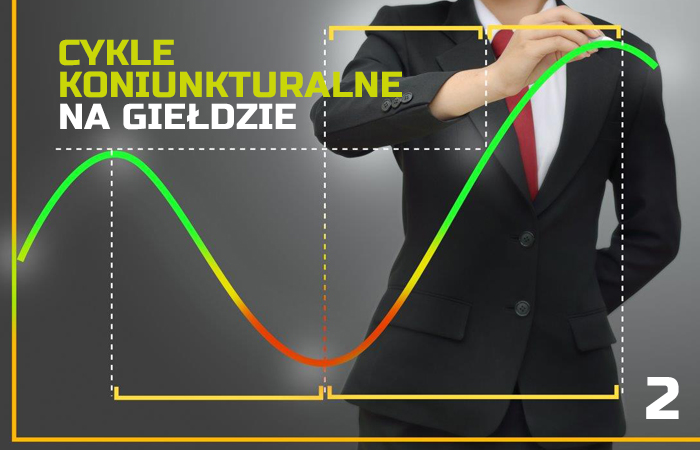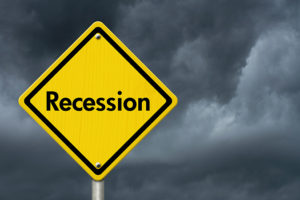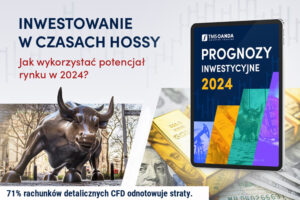Business cycles on the stock market, part II
W previous article we learned about the information mainly about the economic slowdown phase. In addition, we analyzed the main macroeconomic indicators, thanks to which we can more easily identify each phase of the market and determine (among others by their dynamics) when we move from one to the other. In this text, we will focus primarily on describing the next three parts of the cycle. Additionally, you will be able to enrich your knowledge with how economists perceive cycles. We will look at two of the most recognizable and common models that can be used in today's markets. We invite you to read the second part of the topic.
Recession
The last issue we discussed was the slowdown. Recession is the next phase of the cycle that immediately follows it. Undoubtedly, this is the least liked period on the stock exchanges. We associate this time with a bear market and, above all, with losses caused by highly overvalued stocks. In this phase of the cycle, most quotations collapse. Virtually all assets are under the line, and capital escaping from the stock market flows to the so-called safe havens. Cash deposits are on the rise to a large extent, and money goes mainly to government bonds or to the gold market.
READ ALSO: Investing During Recession - Opportunity or Masochism?
The period of recession is a period of strong slowdown. The economy slows down, and entrepreneurs cut production, which adjusts to the current (reduced) demand on the market. This demand is dictated by the high prices of most products, which were driven by high inflation. Declining production necessarily increases unemployment. We can observe them on the basis of several economic indicators. Very good (in the US) are applications for unemployment benefits. Their increase informs us about a reduction in employment (layoffs, closure of some companies) in a given country.
How can we tell when we are moving from a slowdown to a recession? In the case of the slowdown we have already described, its indicator was the maximum level of GDP. The recession, on the other hand, conventionally begins at the peak of the second macroeconomic indicator, i.e. inflation. As the situation changes (high interest rates reduce the pace of price growth), the bank will pursue a policy of lowering rates to stimulate the economy to be more active.
Between the slowdown and the recession
In the recession phase, despite a slowdown in inflation, prices remain high. The central bank is not under pressure related to further reduction of the money flow to the market. The economic situation is still not the best. Economic development is severely lame, and subsequent GDP readings will show a downward trend. The central bank can lower the cost of money in the market. It can do this by reducing interest rates.
The recession phase is a good time to invest in fixed rate bonds rather than floating coupon ones. This is because the present value of future cash flows from future interest at a nominal value increases. Interest is calculated on the basis of interest rates. As they decrease, the floating interest rate and the yield of the debt security will necessarily be smaller. As a result, fixed-rate bonds will perform much better. It is worth adding that the greater the exposure of the debt security to the interest rate, the greater the risk we take.
The recession doesn't last forever
During the recession, central banks reacted to weak economic growth by lowering interest rates. Cheaper credit (including consumers) and deposits with lower interest rates discourage saving. Of course, the transfer of this money to the economy does not happen immediately and is spread over time. Investment outlays in enterprises are gradually increasing and inventories are decreasing (production is increasing). The question is, when are we crossing the magic line between recession and recovery? Overall, the transition between the two phases should determine our GDP. Which is why we should be cautious about looking for a “hole” in the next economic growth readings. It is much more important to spot accelerated GDP dynamics. Apparently, a rising index is a much better indicator of the end of a recession than the proverbial low. Additionally, this information is supported by declining inventories of enterprises and an increase in employment.
Revival
Let's start with the basic point. What kind of investment instruments will we be looking for in this phase of the cycle? The recovery is undoubtedly one of the most enjoyable parts of the entire business circle. This is a good time to invest your capital in overpriced companies. This is the phase in which they have the best purely economic development prospects. The increase in demand, relatively low inflation and growing employment are an extremely attractive moment for the broadly understood group of shareholders. In addition, enterprises are supported by a favorable credit line. The possibility of incurring liabilities cheaply and high investment expenditures will drive us (together with other factors) to increase prices. Only inflation, which begins to gain a significantly increasing pace of growth, will contribute to bringing us into the fourth phase of the business cycle - that is, expansion.
In the recovery phase, all indicators related to the labor market and broadly understood employment will be extremely important. In general, the situation of many enterprises should, proverbial say, "go straight". I mean profitability ratios, possible increase in long-term debt, higher inventories and production costs, or an improvement in revenues.
Due to the low level of interest rates, the profitability of investing in treasury bonds is negligible. If we want to invest in debt securities corporate bonds will be a good option. Enterprises will propose more interesting interest rates due to the desire to attract (when the cost of capital will be lower) this form of lending for their activities.
Expansion
The starting point for this phase is the recovery described above. Increased capital expenditures, intensive employment growth and large-scale lending activities created a good environment for companies to "start" again. An economic environment conducive to development sets higher expectations for companies. Therefore, we will be observing significant expenditures on intangible assets, long-term and short-term investments and an increase in assets in their accounts. Therefore, cash flows from investing activities should be negative.
The good condition of enterprises will translate not only into an increase in production (reduction of inventories), but also into an acceleration of inflation. The clearly higher dynamics of this indicator is an arbitrary point at which we move from the recovery phase to the expansion phase. Taking a closer look at investors who hold stocks in the medium-term (or get rid of them in the event of a downturn in the economy), this is an important moment for them. Thanks to tracking the movements of indexes and CBA and inflation can determine with a high degree of probability the best time to re-enter the market. Of course, the moment we are describing does not last an hour or a day. It is definitely a longer time and it largely depends on the industry and its susceptibility to economic changes. Nevertheless, there is no doubt that missing it will affect the final rate of return.
In addition to stocks, raw materials can be quite a good investment in the expansion phase. I would pay special attention to those that are massively used by manufacturing companies and those from the new technology industry. Of course, the demand for them is largely due to the increased production and production capacities of the companies.
What about inflation?
Admittedly, the massive increase in production and employment is conducive to rising prices. Enterprises dynamically attacking the market are gradually raising the bar in terms of obtaining cheap capital. In order to prevent strongly rising inflation, central banks will decide to raise interest rates to limit the flow of money flowing into the economy. This action does not favorably affect the valuation of bonds (especially those with a fixed interest rate), therefore this instrument is not the best investment choice in the expansion phase.
As is usually the case with manipulating interest rates, they do not have an immediate effect. We will see them only after some time. Nevertheless, one interest rate hike is not enough to be sure that the end of the expansion phase is near. These increases may be differently spread over time (due to inflation deviation from the assumed target and absorption of these decisions by the economy). It is therefore worth taking a closer look at GDP. The peak on this indicator will be the best "warning" signal regarding the end of the fourth phase of the business cycle. Lower economic growth and more expensive credit (high interest rates) will push the economy into a slowdown. At this point, our cycle begins to come full circle again.
Summation
Knowledge of the business cycle is an elementary knowledge that traders often base their strategies on. Even if we do not pay too much attention to diversifying the portfolio in individual phases, this knowledge may be useful for us to sense the moment when it is worth going out or owning larger shares.






















![Forex Club – Tax 9 – Settle tax on a foreign broker [Download the Application] Forex Club - Tax 9](https://forexclub.pl/wp-content/uploads/2024/02/Forex-Club-Podatek-9-184x120.jpg?v=1709046278)
![Trading View platform – solutions tailored to the needs of traders [Review] trading view review](https://forexclub.pl/wp-content/uploads/2024/03/trading-view-recenzja-184x120.jpg?v=1709558918)
![How to connect your FP Markets account to the Trading View platform [Guide] fp markets trading view](https://forexclub.pl/wp-content/uploads/2024/02/fp-markets-trading-view-184x120.jpg?v=1708677291)
![How to invest in ChatGPT and AI? Stocks and ETFs [Guide] how to invest in chatgpt and artificial intelligence](https://forexclub.pl/wp-content/uploads/2023/02/jak-inwestowac-w-chatgpt-i-sztuczna-inteligencje-184x120.jpg?v=1676364263)


![WeWork – the anatomy of the collapse of a company valued at $47 billion [WeWork, part II] wework bankruptcy story](https://forexclub.pl/wp-content/uploads/2024/04/wework-bankructwo-historia-184x120.jpg?v=1711729561)
![Adam Neumann – the man who screwed up Softbank [WeWork, part AND] adam neumann wework](https://forexclub.pl/wp-content/uploads/2024/04/adam-neumann-wework-184x120.jpg?v=1711728724)





![How to transfer shares to another brokerage office [Procedure description] how to transfer shares to another brokerage house](https://forexclub.pl/wp-content/uploads/2024/03/jak-przeniesc-akcje-do-innego-biura-maklerskiego-184x120.jpg?v=1709556924)

![The most common mistakes of a beginner trader - Mr Yogi [VIDEO] Scalping - The most common mistakes of a beginner trader - VIDEO](https://forexclub.pl/wp-content/uploads/2024/03/Scalping-Najczestsze-bledy-poczatkujacego-tradera-VIDEO-184x120.jpg?v=1711601376)
![Learning patience: No position is also a position - Mr Yogi [VIDEO] Scalping - Learning patience - No position is also a position - VIDEO](https://forexclub.pl/wp-content/uploads/2024/03/Scalping-Nauka-cierpliwosci-Brak-pozycji-to-tez-pozycja-VIDEO-184x120.jpg?v=1710999249)
![When to exit a position and how to minimize losses - Mr Yogi [VIDEO] Scalping - When to exit a position and how to minimize losses - VIDEO](https://forexclub.pl/wp-content/uploads/2024/03/Scalping-Kiedy-wyjsc-z-pozycji-i-jak-minimalizowac-straty-VIDEO-184x120.jpg?v=1710336731)

















